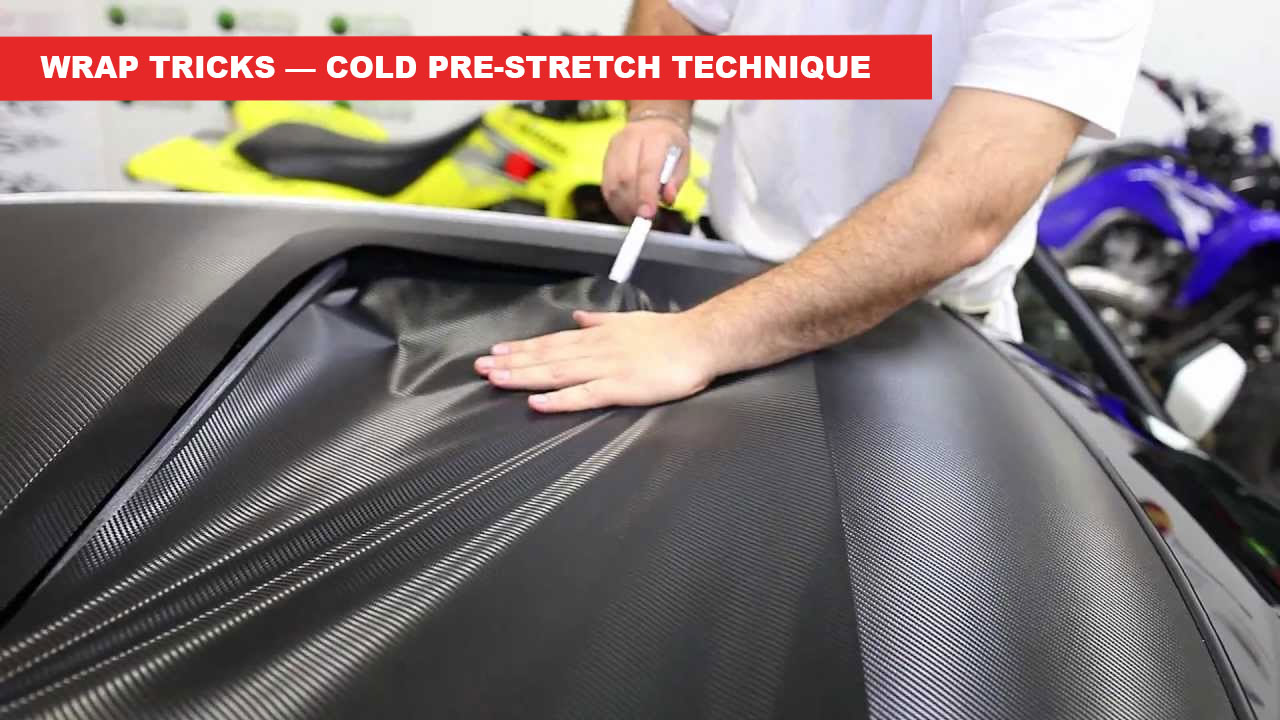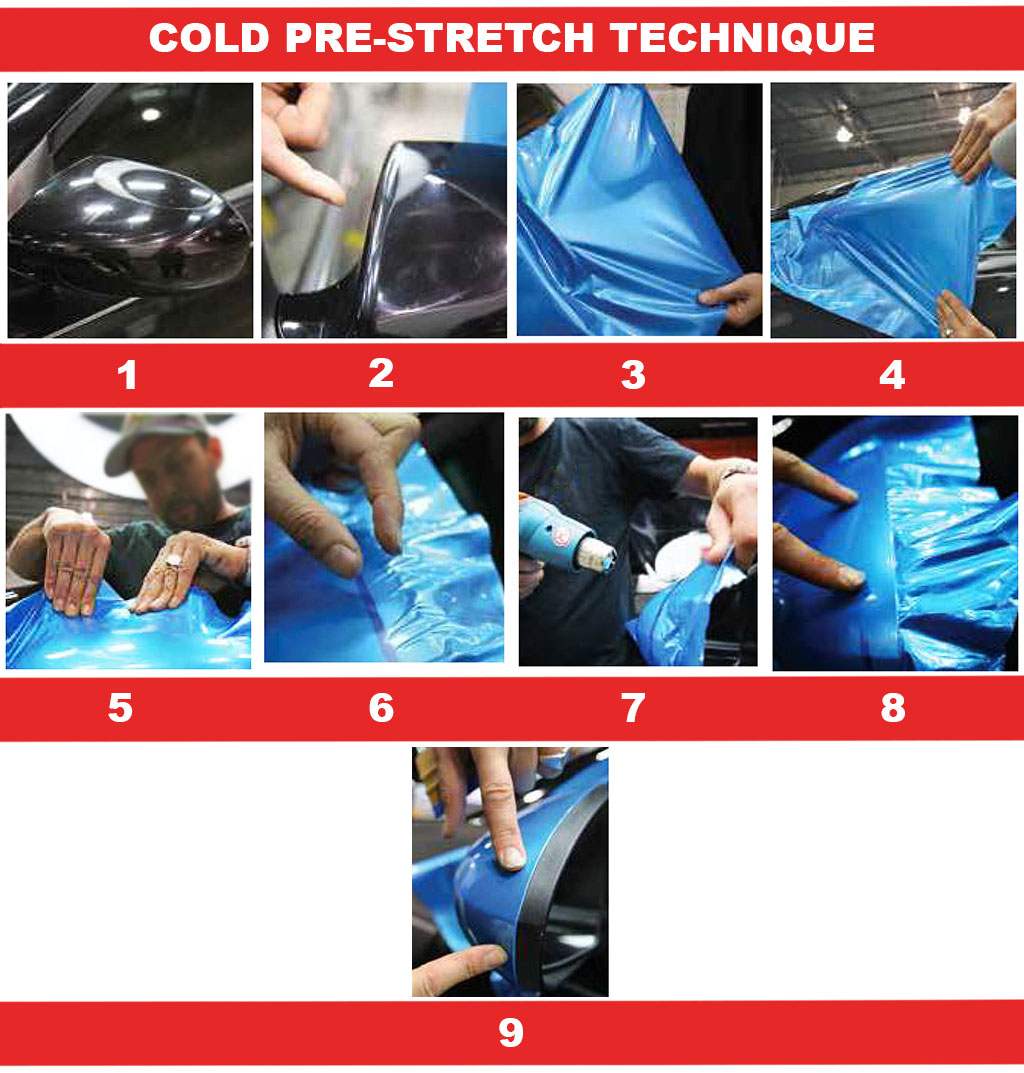Vinyl Wrap Tips - Cold Pre-Stret
 Vinyl Wrap Tips - Cold Pre-Stretch Technique
Vinyl Wrap Tips - Cold Pre-Stretch Technique
In 2009, a group of German vinyl wrap installers discovered the pre-stretch technique and it revolutionized how installers wrapped difficult areas such as mirrors and bumpers. The only drawback to the pre-stretch technique is it only works gloss, matte and gloss/matte metallic films.
At present, textured films like Brushed Metallic, Carbon Fiber and multi-layered films
like as Chrome, the film distorts or whitens when the technique is
applied. As good as pre-stretch is, it's limited.
One of the most frustrating things about wrapping anything with vinyl films
is that they have a tendency to "shrink back" after having been installed on
curved, convex and concave surfaces. According to Justin Pate of the Wrap
Institute, all PVC film has a memory which means that it will tend to return to
its size. In other words, when you heat PVC film it goes back to its original
shape and tension. Clearly this is a double edged sword. Why is that? Well,
imagine the scenario below and you might get a better idea.
When a Good Memory Is Great
You've just received a roll of 3M™ Matte Red Metallic film. If you're a DIY
installer or amateur you might not be familiar with the film and how thin it is.
As a result, it folds in upon itself as soon as you remove the paper liner. Now,
luckily for you, 3M™ 1080 Series films feature Controltac™ adhesives for a
low-tack initial bond so you're able to flatten it all out again. But, once you
have the results aren't pretty — that is, until you add some heat! As soon as
you do, the ripples and dimples vanish as the vinyl wrap film returns to its
former shape thanks to its memory. So, memory is a great thing, right? Well, not
always.
When Amnesia Might Be Better
There are some cases where you'd rather your wrapping vinyl have a case of
amnesia. Prime examples of this are when you find yourself trying to wrap a
mirror, your hood or anything with more than a 180-degree angle. You see, most
of us do-it-yourselfers, can wrap anything pretty quickly. Sure, getting the
fingers out when you're wrapping an extreme curve can be a little time consuming
but we've all been there and succeeded. Unfortunately, those moments of victory
are usually extremely short-lived. A vinyl wrap that looked good one day one
starts to look less spectacular on day two until the film has finally retreated
up to a quarter of an inch from the edge of whatever it's supposed to be
covering. And why? Memory.
Cold Pre-Stretching — A Miracle Solution to Vinyl Memory
According to Justin Pate, a Japanese installer named Koji Yamaguchi taught
him the cold pre-stretch technique while wrapping a door handle that he,
himself, had learned eight years previously in Germany. In essence, in order to
pre-stretch the material you heat it and then stretch it to about 2 to 4 percent.
You then allow it to return to its normal size. At present this technique only
works with gloss and matte films but it's a life-saver nonetheless
Sounds simple, right? Clearly we've glossed over a lot of the details which
is why we'll present the video in its entirety below. But, in case you're a list
lover, we've included the steps you need when wrapping a curved surface like a
rear view mirror:
- Begin on the back side of the rear view mirror sinc eit has the steepest
angle.
- Anchor the film and ensure that there is an equal amount on either side
of the mirror's face.
- Use Justin Pate's "triangle technique" and pul firmly in order to
stretch the film onto the surface to be wrapped.
- Even out the tension with your fingers.
- Once evenly distributed on the mirror, keep the stretched material
(stretched from 2 to 4%) about an inch from the edge.
- If doen correctly, the wrinkles at the edges will be very loose and soft
instead of tight and sharp.
- When the excess is cut away the, the wrap will stay for years.
Here are the step by step pics to help you see exactly how it's done:

And, finally, here's the
video for your viewing
pleasure.